

The beautiful Lake Constance region of Southern Germany is a major apple production area.
Travelling with five friends, The English Apple Man visited Southern Germany last week; on Wednesday 5th August we flew from London Heathrow to Munich before driving down to our Hotel at Friedrichshafen.
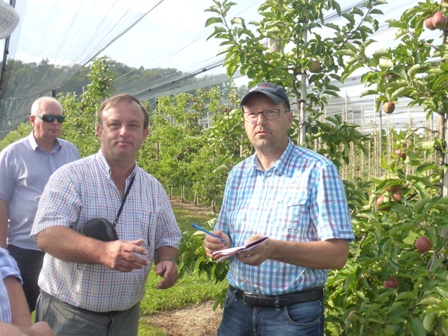 The visit was organised by FAST Adviser - James Shillitoe who had visited the Lake Constance region before and was familiar with the work of Michael Winstel and Peter Trilof and felt a visit to Lake Constance would be a valuable 'learning curve' for growers and advisers alike!
The visit was organised by FAST Adviser - James Shillitoe who had visited the Lake Constance region before and was familiar with the work of Michael Winstel and Peter Trilof and felt a visit to Lake Constance would be a valuable 'learning curve' for growers and advisers alike!
Our group of six included James Shillitoe's FAST colleague John Clarke, Stuart Woods who farms near Teynham in East Kent, Stuart's son-in-law - John Clinch whose family have farmed in the area for more than 300 years and Stuart O'Leary who grows apples in Suffolk + The English Apple Man.
It was warm on our arrival in Friedrichshafen and following a 'freshen up' we soon sampled the local brew. Its funny how a cold lager always tastes so much better in a hot climate, and it was certainly hot while we were in Lake Constance. Comfortably into the 30 + degrees C by breakfast time, the temperature in the afternoon was in the high 30's and on Thursday afternoon we were melting as the barometer crept over 40 C.
The region is a major producer of apples and pears; the marketing community - Bodenseeobst eG (MaBo) founded in 1970 is one of the largest German producer organisations (PO's) and the production area covers around 4,500 hectares and produces circa 80,000 - 120,000 tonnes each year, depending on the weather.
The average size apple farm is 10 hectares, but many are just 2 -3 hectares and the largest 80 hectares.
James Shillitoe's attendance at "SuproFruit 2015", the 13th Workshop on Spray Application Techniques in Fruit Growing" held at Lindau, Lake Constance, Germany, from July 15th -18th 2015 endorsed his belief that a grower visit to Lake Constance would be very worthwhile.
WOG - Württembergische Obstgenossenschaft Raiffeisen eG
Our first visit was to a farm belonging to WOG Producer Organisation (PO) where we met Klaus Altherr from WOG who explained the tree management process developed by his WOG colleague Michael Winstel.
Klaus took us into Kanzi, Braeburn and Jonagold orchards; mature Kanzi, Braeburn and Jonagold and young Red Jonaprince (a Jonagold clone).
To achieve consistent yields of quality apples the tree needs to be (and remain) perfectly balanced. The best way to keep a tree balanced is with regular cropping; this requires understanding the characteristics of each variety and following the formula for success. Braeburn is often described as having 'biennial characteristics' but its ability to produce very heavy crops means it must be managed well to avoid 'on off' cropping. Thinning the tree to avoid over-cropping will assist in the tree balance.
But it is not just a case of thinning. Klaus demonstrated how they manage the tree from its first year in the ground (1st leaf) by tying down branches to take the vigour out of the branches and encourage fruit bud; the process continues with management of branches as the tree grows upwards.
Below: Kanzi orchard in Lake Constance
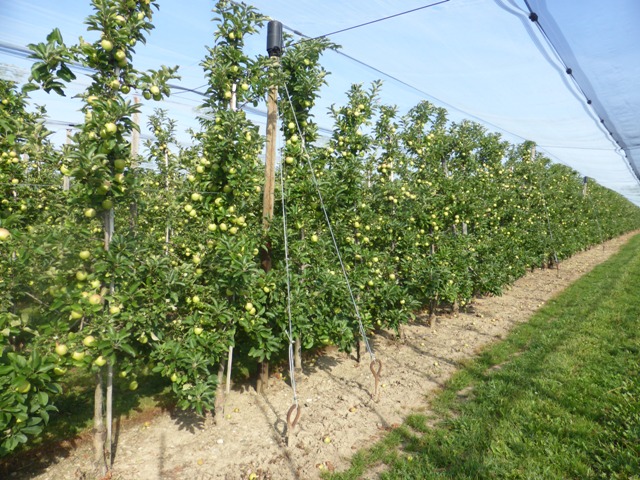
Tying down the young branches with string is an accepted way of branch training, but Klaus showed us another simpler strategy which he an Michael Winstel have been trialing; by gathering the young branches downwards and taping them into this position in March, before releasing them about a month later, it is possible to 'set' them in a downward position. Klaus said it is important to check the response by removing the tape on number of trees after 2-3 weeks and observing the response. If the branches have not responded sufficiently, tape them down again. It is very important NOT to leave the tape on too long as they will stay in position facing downwards.
Below: Klaus demonstrates training a young Red Jonaprince tree

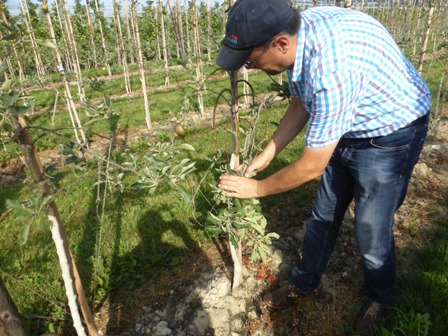
Keeping the tree shape - a taper - requires removing fruiting branches before they become dominant - the 'rule of thumb' is not to let a branch become more than half the thickness of the tree trunk. In practice the lateral branch may need to be removed earlier; that is down to grower judgement. When the branch is removed leaving a stub is important allowing new shoot growth which may need tying down (depending on its natural angle) to ensure a perfect 'below horizontal' new potential fruiting lateral.
Klaus said it is also important to maintain a space between the trees allowing light interception; "it should be possible (he said) to look through several rows. The Kanzi trees are grown to a height of 3.5 metres and spacing is; 1 metre in the row with rows 3.2 metres apart.
Ensuring a fruit set is key to regular cropping and Klaus stressed the importance of the tree being balanced; by using Regalis - (a growth regulator) to slow vegetative growth at pink bud and again at petal fall, the competition from vegetative growth is reduced enhancing fruit set. Plant growth regulators (PGR) are organic compounds which are produced naturally or synthetically.
The objective is to produce trees that are 'calmer' (an often used term) by fine tuning to maintain the perfect balance between tree vigour and cropping.
Below: The first picture shows the slender profile of the tree - and - where a branch was removed a new shoot which will become a new fruiting lateral
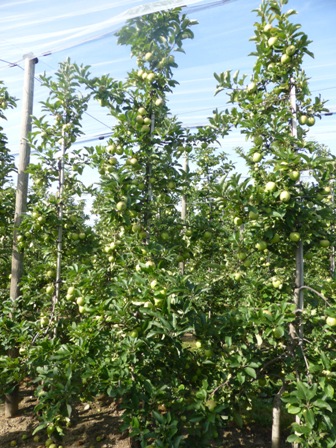
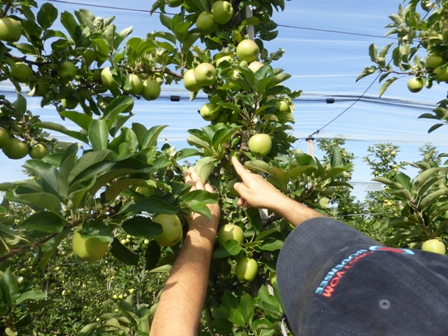
This year, at Easter when the Jonagold trees were at the 'green bud' stage temperatures fell to -4.5 C between the Sunday - Tuesday and as a result the lower branches have suffered frost damage and a loss of crop. Jonagold which has the first flowers to open in the region, is less resilient to low temperatures than other varieties.
Klaus also said the climate is changing in Lake Constance - we are no longer getting a good 'soaking' rain; "we get showers and thunderstorms" but not the good soaking we need to replenish soil moisture. We were not the only one's to find the weather hot - Klaus said it is at least 5 degrees C warmer than the normal summer temperature. While it is hot now, winter temperatures can drop to -25 C.
Below: A Jonagold row showing poor crop set on lower branches - and - Jonagold tops
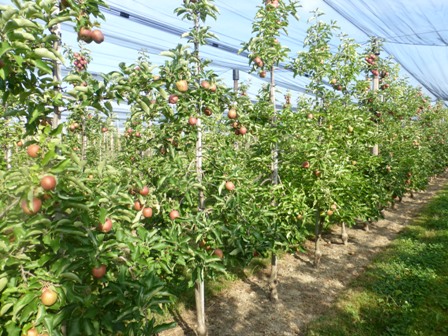
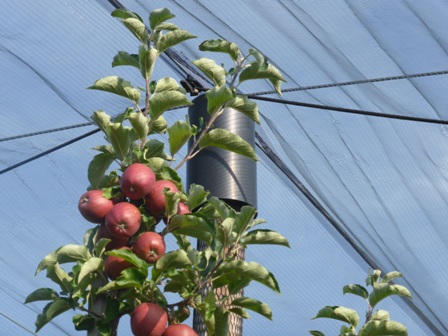
Before lunch we drove across the regional border into Bavaria to visit a Bibaum orchard.
Below: Elstar apples growing on Bibaum (twin leader) trees
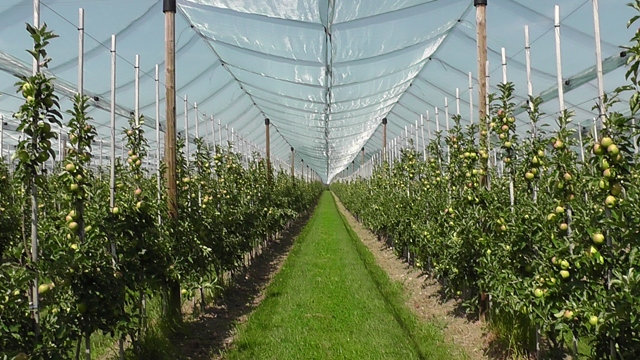
Below: The Elstar trees a side view - and - our group (the EAM is behind the camera) with Klaus in the Elstar orchard
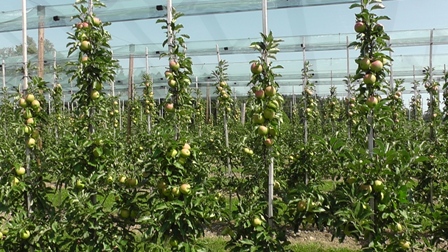
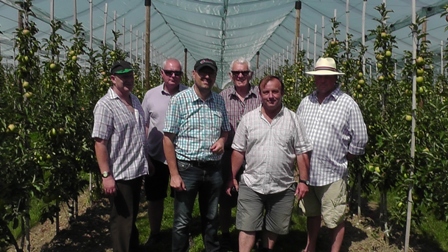
Below: We had Lunch at a traditional Bavarian Restaurant on a hill with views across vines and orchards with Lake Constance and Mountains in the distance
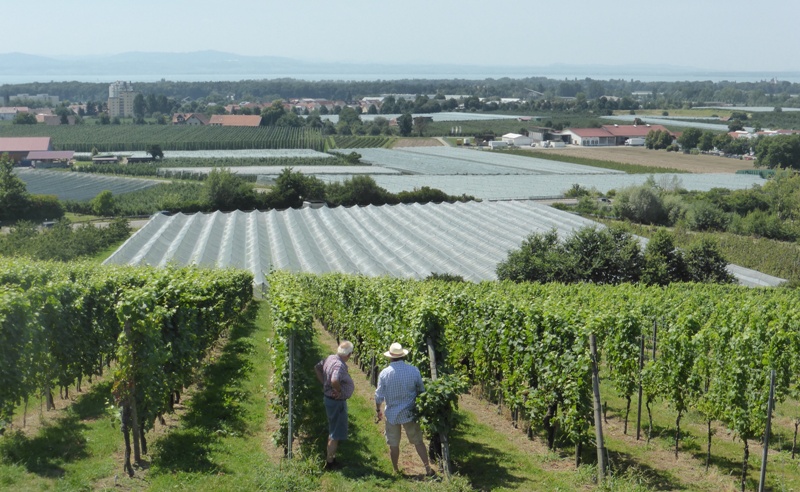
Below: Bavarian Villages are very pretty - and - Bavarian waitresses equally so..........
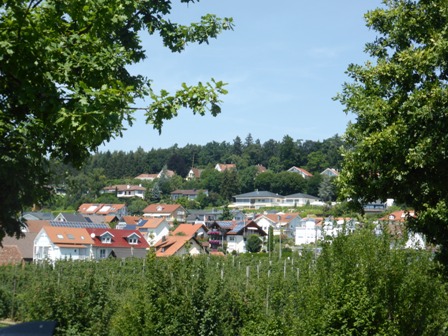
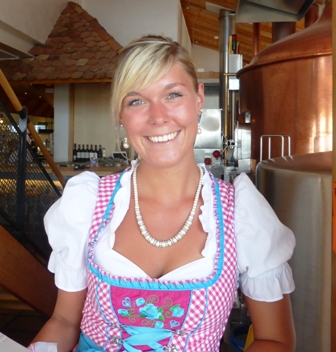
Friedrichshafen is the home of the Zeppelin and today tourists can take tours over Lake Constance and the beautiful surrounding countryside which borders on Germany, Switzerland and Austria.
Below: a modern tourist version of the legendary Zeppelin

Visit the Zeppelin Museum in Friedrichshafen
The visit to Lake Constance generated a lot of useful information and The English Apple Man will cover much of it in the coming weeks, of especial interest will be the visit to Peter Trilof and his work on fruit sprayer 'air movement' using an 'Ultrasonic' test rig to assist in 'fine tuning' orchard sprayers to deliver both efficacy and minimal drift.
At the end of a very hot day in the apple orchards we spent our evening in Friedrichshafen in a Lakeside Restaurant enjoying Wiener Schnitzel washed down with cold local beer - "Wunderbar"
Below: Stuart Woods and our waiter Konstantinos (in Lederhosen) - and - John Clinch, The English Apple Man and Stuart Woods
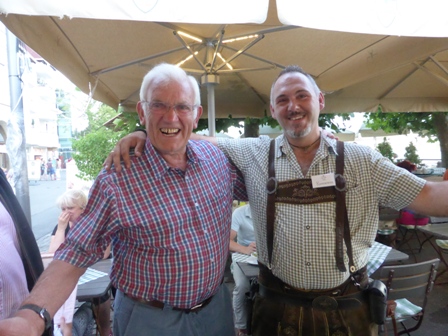

Finally - today is the 6th anniversary of The English Apple Man - the first Journal was published on 14th August 2009 To visit the first Journal Click on English Apple Man Journal for 14th August 2009
Next week The English Apple Man Journal will report on the results of two orchard competitions
Take care
The English Apple Man